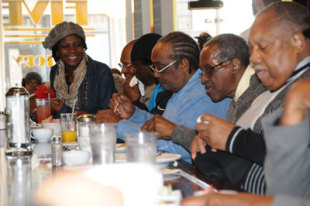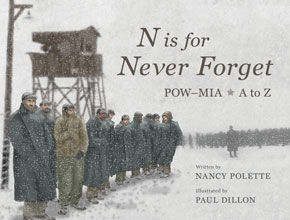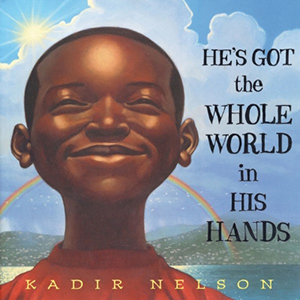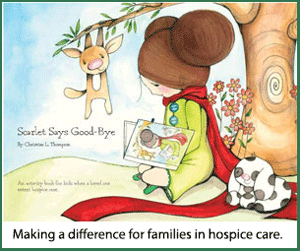In our January issue, we brought you the backstory of how a children’s book author prompted a new day in court for a group of civil rights activists known as the Friendship Nine, half a century after they served jail time for attempting to sit at a whites-only lunch counter in Rock Hill, South Carolina. Due to the overwhelming response from our readers, this month we bring you coverage of the historical events that followed.
“This is the day the Lord has made,” began children’s author Kimberly Johnson as she stood with Bernice King, daughter of Dr. Martin Luther King Jr., and surviving members of the Friendship Nine in the crowded South Carolina courtroom. “The world has become a better place because of what has happened here today. Our children are the ones who will benefit…They will see that the universe is on the side of justice.”
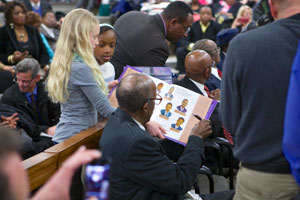
Children gathered in the courtroom with copies of Kimberly’s book No Fear For Freedom to share the historic moment with their local heroes. Photo by Keith Wilk.
The courtroom was packed to capacity with a racially-diverse mix of friends, family members, local officials, journalists from every major news outlet in America, and children clutching copies of Kimberly’s children’s book, No Fear For Freedom: The Story of the Friendship 9.
Seven of the surviving Friendship Nine men, all in their seventies, came in dressed in their Sunday best, some aided by a cane, wheelchair, or friendly arm.
As the court came to order on January 28, 2015, Circuit Court Judge John C. Hayes III read each of their names. Each man stood or raised a hand when called.
After each name, the judge said: “Offense: trespassing. Disposition: guilty. Sentence: $100 or 30 days. Conditions: Sent to chain gang.”
Then, Judge Hayes, whose uncle sentenced the Friendship Nine in the original case, vacated the convictions of all nine men: John Alexander Gaines, Thomas Walter Gaither, Clarence H. Graham, Willie Thomas Massey, Willie Edward McCleod, Robert L. McCullough, James Frank Wells, David Williamson Jr., and Mack C. Workman.
All were in attendance except Mr. Gaither, who sent his son in his place when inclement weather delayed his travel, and Mr. McCullough, who died in 2006.
The men were represented by Ernest A. Finney Jr., 83, who had defended their case fifty-four years ago and later served as South Carolina Supreme Court’s first black chief justice.
In his ruling for acquittal, Judge Hayes said the convictions had been “predicated upon values and beliefs that have since been deemed to violate the fundamental guarantees” of the Constitution.
“We cannot rewrite history,” he said, “but we can right history.”
The sit-in by the men on January 31, 1961, had been a small but important moment in the civil rights movement. The clean-cut students from the now-closed Friendship Junior College had been arrested for sitting at a whites-only lunch counter, convicted of trespassing, and ordered to pay a $100 or serve 30 days of hard prison labor. Their decision to choose the jail sentence reinvigorated the civil rights movement across America as other activists imitated their “Jail, No Bail” tactic.
“The only reason these men were arrested was because they were black,” stated 16th Circuit Solicitor Kevin Brackett, who apologized on behalf of the state for the 1961 wrongdoing. “It was wrong then. It is wrong today…Our community here and our country is a better place because of what y’all did.”
In most vacated criminal cases, the records related to the conviction are destroyed. But Brackett asked that the records be maintained in this case, so the men would be remembered.
Judge Hayes agreed. “This will remain part of our history as corrected,” he said, noting that his uncle, who died in 2002, would have been delighted that the court made amends.
In the same hearing, additional records were vacated, including those of Charles E. Taylor, who was arrested with the Friendship Nine but paid the fine, and four activists who staged similar “jail, no bail” protests in Rock Hill. Three of those four activists are still alive, and two of them, Charles Melvin Sherrod and J. Charles Jones, were present in court.
Charles Jones addressed the crowd after the court hearing. “How lifted we are!” he said. “I was one of the four students who came up from Atlanta, having read about these young men, and being so inspired. We said: ‘We’ve got to go there. We got to join them.’ And we spent thirty days of hard labor.”
Then, Mr. Jones, shaking with emotion, began singing Sam Cooke’s 1960 hit song “Chain Gang.”
“Can you feel it? Can you imagine?” he said. “After all this time, here we are, before the globe, being respected. And we never thought that would happen.”
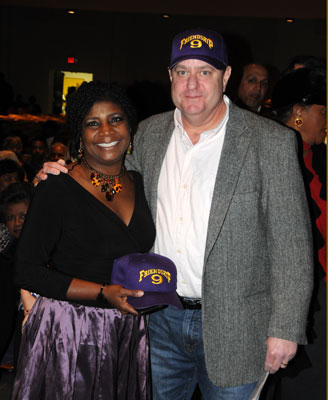
Kimberly enjoys a candid moment at her musical’s premiere with Kevin Brackett, who was instrumental in getting the men’s records vacated. Kevin’s daughter performed in the musical. Photo by Karen Pavlicin-Fragnito.
It happened largely because Kimberly Johnson was so moved by her experience writing her children’s book No Fear For Freedom. “I felt strongly that more needed to be done to celebrate these men,” she says.
Her efforts began in earnest after she met Bernice King and began studying Dr. King’s philosophies on nonviolence. She discovered many similarities between what Dr. King talked about and the courageous efforts of the Friendship Nine. It was a challenging, emotional journey getting to that courtroom, and she says it doesn’t quite feel real yet.
“It’s hard to believe that their records have been cleared,” Kimberly says. “We waited for the day to come and now that it is here—it seems surreal.” The Friendship Nine members feel the same way.
Clarence Graham says, “I do believe that heaven smiles on this movement.” He views this historical turn as an opportunity to impact the next generation of youth. “We have a chance to show young people that things can be done right.”
Throughout the week following the court hearing, the surrounding community celebrated the moment and honored the Friendship Nine with a variety of events, including three performances of Kimberly’s original musical, also titled No Fear For Freedom. Cowritten with songwriter/musician Bruce McKagan, the musical uses the men’s story to demonstrate the hopefulness communities can gain through adversity. The actors were all community theater volunteers, many in their first performance. The response was so positive, the musical will soon be available on DVD and the troupe has been invited to travel for encore performances.
On January 31, 2015, the anniversary day of their famous one mile walk from Friendship Junior College to McCrory’s Variety Store, the surviving members of the Friendship Nine were joined by a few of the “City Girls” who had protested with them in the 1960s—and hundreds of citizens from as near as Main St in Rock Hill and as far away as Minnesota—to walk with them from the memorial arches of Friendship Junior College to the lunch counter at what is now the Five & Dine. Cast members from the No Fear For Freedom musical led the crowd in song.
And then the Friendship Nine, surrounded by people of all ages and races holding signs of support and reaching out to shake the men’s hands in gratitude, walked into the diner to the meal they had set out to have fifty-four years earlier. The mayor and chief of police held the door open and shook their hands as the men entered with clear records, welcomed.
Willie McCleod sat down at the counter on a stool that now has his name engraved on it, smiled, and shook his head, overcome with emotion. Five & Dine owner Selena Kelemen handed him a cup of coffee and took his order for breakfast.
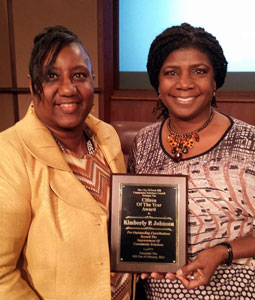
Carol Harvey of City of Rock Hill Community Relations Council presents Kimberly Johnson (right) the Citizen of the Year Award. Photo by Jeff Johnson.
Kimberly and the Friendship Nine have since been invited to multiple schools and communities to talk about the experiences of 1961 and 2015. They have been interviewed around the world and they are working on a documentary.
On February 10, in recognition of Black History Month, the City of Rock Hill Community Relations Council presented a special forum with the Friendship Nine, “54 Years Later: The March Continues,” giving local citizens the opportunity to meet and talk with the men. Following the discussion, the council presented its Citizen of the Year Award to Kimberly for her “outstanding contributions toward the improvement of community relations.”
Humbled, Kimberly says she is eternally grateful for all these men have done to pave a path for others. Inspired by what her community was able to give back to these men by working together, she plans to continue to work more closely with law enforcement and other community organizations to encourage youth to find peaceful resolutions to their problems.
“We have to get our youth involved in the community and the decision making process,” she says. “When we can do that, youth can make better choices about what impacts their lives.”
She adds, “There is no perfect community, but together we can accomplish so much good. This moment in history has proven that.”
Kimberly Johnson
Web: www.SimplyCreativeWorks.com
Facebook: /SimplyCreativeWorks
Friendship Nine
Web: www.Friendship9.org
Facebook: /FriendshipNine
Buy the book No Fear For Freedom: SimplyCreativeWorks.com, Amazon.com, MilitaryFamilyBooks.com
Photos courtesy of Kimberly Johnson.
Feature photo: Kimberly celebrates with the Friendship Nine at the Five & Dine lunch counter following the commemorative walk on the 54th anniversary of the men’s protest that initiated “Jail, No Bail.” Photo by Karen Pavlicin-Fragnito.
Karen Pavlicin-Fragnito is the publisher of Books Make a Difference. She felt humbled, grateful, and honored to celebrate this historic moment with Kimberly, the Friendship Nine, the City Girls, Bruce McKagan, Kevin Brackett, the cast of No Fear For Freedom, and her cousins. She is still singing songs from the musical.
Brief video clips from the event by Karen Pavlicin-Fragnito:
Clip 1: Cast members of the No Fear For Freedom musical led the crowd in song on the commemorative walk with the Friendship Nine, January 31, 2015, Rock Hill, SC.
Clip 2: An emotional moment for Kimberly Johnson, author of No Fear For Freedom, as she talks with the crowd on Main St. in Rock Hill, SC, following the commemorative walk January 31, 2015. Members of the Friendship Nine and City Girls sit in front, with the cast members who represent them in the musical standing behind them.
Clip 3: Very brief clip of the City Girls and Friendship Nine with family and friends at the Five & Dine in Rock Hill, SC, following the commemorative walk January 31, 2015 and celebrating the men having their records cleared in court after 54 years. Karen says: “I didn’t spend much time video recording because I wanted to spend as much time as possible listening to their stories! What an amazing group of people. So blessed to have the chance to talk with them.”
This article was first published in March 2015.

